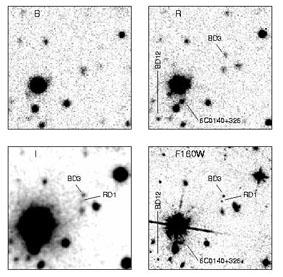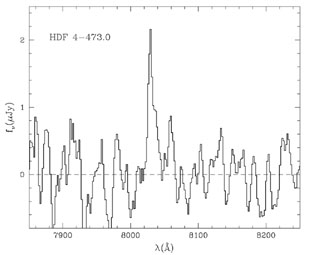


In recent years our understanding of the earliest stages of galaxy
formation and evolution has been revolutionized. With the commissioning
of the Keck telescopes atop Mauna Kea and the availability of deep
ground- and space-based imaging, the photometric technique outlined in
Steidel & Hamilton
(1992)
has been used to routinely select high-redshift, star-forming
systems. Dubbed the "Lyman-break" method, objects are identified on the
basis of the redshifted continuum spectral discontinuity at (1 +
z) × 912 Å and relatively flat (in
f ) continua
longward of the redshifted
Ly
) continua
longward of the redshifted
Ly [at (1 + z)
× 1216 Å], as we expect from hot O and B stars. At the largest
redshifts (z
[at (1 + z)
× 1216 Å], as we expect from hot O and B stars. At the largest
redshifts (z
 4), absorption
due to the Ly
4), absorption
due to the Ly and
Ly
and
Ly forests
plays a role of equal or greater importance in attenuating the deep UV
continua. These hydrogen absorptions from the Lyman limit and the Lyman
forests cause high-redshift objects to effectively disappear in the
bluer passbands. The technique is therefore sometimes referred to as the
"dropout" technique (see Figs. 4 and
5). U-band dropouts were initially used
to chart the distant universe at z ~ 3
(Steidel et al. 1996a,
1996b).
This technique has now been pushed to higher redshifts: first to
z
forests
plays a role of equal or greater importance in attenuating the deep UV
continua. These hydrogen absorptions from the Lyman limit and the Lyman
forests cause high-redshift objects to effectively disappear in the
bluer passbands. The technique is therefore sometimes referred to as the
"dropout" technique (see Figs. 4 and
5). U-band dropouts were initially used
to chart the distant universe at z ~ 3
(Steidel et al. 1996a,
1996b).
This technique has now been pushed to higher redshifts: first to
z  4
(Dickinson 1998;
Dey et al. 1998;
Steidel et al. 1999),
and now finally above z = 5
(Weymann 1998;
Spinrad et al. 1998).
4
(Dickinson 1998;
Dey et al. 1998;
Steidel et al. 1999),
and now finally above z = 5
(Weymann 1998;
Spinrad et al. 1998).
 |
Figure 4. Detail of the Keck/LRIS
BRI and HST/NICMOS F160W (~ H) images of the
0140+326 field. The images shown are 27".5 on a side; north is up
and east is to the left. Objects at high redshift can be systematically
and robustly selected on the basis of redshifted Lyman line and
continuum absorptions of hydrogen. The galaxies targeted as
B-band "dropouts" are labeled BD3 and BD12 and lie at z =
4.02 and z = 3.89, respectively. The serendipitously discovered
z = 5.34 galaxy is labeled RD1 (R-band dropout; Dey et al. 1998) in this figure. 6C 0140+326
(Rawlings et al. 1996)
was the most distant radio galaxy known at the time of the deep imaging
and lies at z = 4.41. It is also a B-band
dropout. Hydrogen absorption from the redshifted Lyman break and
Ly |
 |
Figure 5. Spectrum of HDF 4-473.0. The
total exposure time is 4 hr. It was selected from the deep HST
optical and near-infrared images of the HDF
(Williams et al. 1996;
Thompson et al. 1999)
as a V606 dropout (V606 > 30;
I814 = 27.1 AB). The spectrogram shows a single
emission line at 8029 Å. The asymmetric line profile and broadband
colors are most consistent with this being
Ly |
The hydrogen absorptions are ubiquitous: they are present in the spectra
of O and B stars which will dominate the rest-frame UV continua of
young, star-forming galaxies with conventional mass functions. They are
also present for any system with a substantial hydrogen column present
along our line of sight. In particular, bound-free absorption of
hydrogen at the Lyman limit [at (1 + z) × 912 Å] will
severely truncate a background spectrum if the total neutral hydrogen
column at the relevant wavelength exceeds nH
 3 ×
1017 cm-2. Thus, Lyman absorption is expected even
in systems whose spectral energy distributions are not dominated by hot,
young stars; similar techniques have routinely been used to identify
high-redshift quasars from deep multiband imaging such as the Palomar
Observatory Sky Surveys (e.g.,
Kennefick, Djorgovski,
& de Calvalho 1995;
Stern et al. 1999c)
and the Sloan Digital Sky Survey
(Fan et al. 1999).
3 ×
1017 cm-2. Thus, Lyman absorption is expected even
in systems whose spectral energy distributions are not dominated by hot,
young stars; similar techniques have routinely been used to identify
high-redshift quasars from deep multiband imaging such as the Palomar
Observatory Sky Surveys (e.g.,
Kennefick, Djorgovski,
& de Calvalho 1995;
Stern et al. 1999c)
and the Sloan Digital Sky Survey
(Fan et al. 1999).